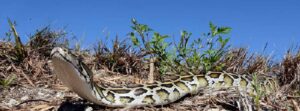
Deerfield-News. com-Deerfield Beach, Fl-Iguana Iguana is not the only invasive non-native species Florida is now home to. The Burmese Python has become more than a nuisance in the Everglades. So much so that the State of Florida is investigating why they contain a high amount of mercury and are they safe to eat. That’s right Florida is checking out the possibility of encouraging residents to eat our way out of invasion. Now for those who remember the State of Florida also recommended a couple of years ago that Floridians shoot Iguanas where we see them.
Regulatory Status
Burmese pythons are not native to Florida and are considered to be an invasive species due to their impacts to native wildlife. This species is not protected in Florida except by anti-cruelty law. Pythons can be killed on private property with landowner permission and can also be killed year-round and without a permit on 25 public lands in south Florida. The FWC encourages people to kill wild caught pythons whenever possible.
Captive held Burmese pythons are regulated as a Conditional species in the State of Florida. A permit is required to possess pythons for the purposes of commercial sales, public exhibition, or research. Pythons cannot be acquired in Florida as personal pets.
Description
 The Burmese python is one of the largest snakes in the world. Adult Burmese pythons caught in Florida average between 1.8 m (6 ft) and 2.7 m (9 ft); the largest Burmese captured in Florida measured over 5.4 m (18 ft) in length.
The Burmese python is one of the largest snakes in the world. Adult Burmese pythons caught in Florida average between 1.8 m (6 ft) and 2.7 m (9 ft); the largest Burmese captured in Florida measured over 5.4 m (18 ft) in length.
Burmese pythons are tan in color with dark blotches along the back and sides. The blotches look like puzzle pieces or the markings on a giraffe. They have a pyramid-shaped head with a dark, arrowhead-shaped wedge extending toward the nose.
Burmese pythons are semi-aquatic and are often found near or in water. They are excellent climbers and can be seen in trees.
Often cited as having a docile nature, Burmese pythons are popular in the pet trade. However, they are currently listed as a conditional species in Florida and can no longer be acquired as pets in the state. They are also federally listed by the U.S. Fish and Wildlife Service as an Injurious Species under the Lacey Act, which prevents the importation of pythons into the United States.
Diet
In Florida, Burmese pythons have been found to prey upon a variety of mammals, birds and even alligators.
Native Range
India, lower China, the Malay Peninsula and some islands of the East Indies.
Florida Distribution
A population of Burmese pythons is established in South Florida. Historically, the python population was centered within Everglades National Park in Miami-Dade County. Recent data indicate that the population is expanding to the north and west. Individuals have been found in southwest Florida in Naples and near Lake Okeechobee. Python observations outside of south and southwest Florida are likely escaped or released pets.
Potential Impacts
Because of their large size, adult Burmese pythons have few predators, with alligators and humans being the exceptions. They prey upon native species and may reduce their populations locally. Research is underway to ascertain the impacts pythons have on native mammal species. While pythons will eat common native species and exotic species such as Norway rats, they can also consume threatened or endangered native species. For instance, pythons have been known to eat endangered Key Largo wood rats.
Burmese pythons can pose a threat to human safety. Pythons may also prey upon pets such as cats and dogs.




































